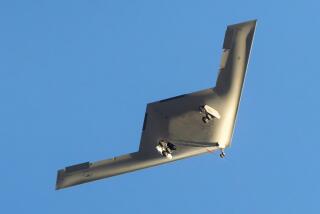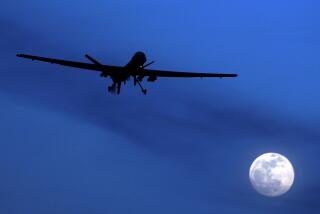Future Air Combat Has No One in It
- Share via
A prototype of a pilotless fighter jet that would autonomously attack an enemy and return to base made its first flight Wednesday, taking a major step toward revolutionizing the way battles will be fought in the future.
Boeing Co.’s X-45A aircraft took off from a dry lake bed at Edwards Air Force Base, flew for 14 minutes and then landed back on the lake bed, company and Pentagon officials said. It was controlled by an on-board computer that had been preprogrammed with flight instructions, rather than remotely piloted by a human with a joystick.
Sometime in the next decade, military strategists envision using a swarm of such unmanned combat air vehicles, or UCAVs, to carry out the most dangerous elements of combat, knocking out enemy air defenses such as radars and antiaircraft missiles so that piloted fighters and bombers can strike targets on the ground and in the air. Pentagon officials and defense analysts said the maiden flight of the X-45A represented a “quantum leap” in the development of such aircraft.
“It will transform the way we will fight in the future,” said David Lanman, who oversees unmanned aircraft development at the Air Force Research Laboratory in Ohio.
Although it wasn’t the first time that an aircraft flew autonomously--rudimentary systems had been tested decades ago on reconnaissance planes--the X-45A is the world’s first unmanned attack jet to do so.
The X-45A has attracted particular attention since the Sept.11 terrorist attacks and subsequent military action in Afghanistan. Military operations there have highlighted the utility of unmanned aircraft for gathering military intelligence, such as Northrop Grumman Corp.’s Global Hawk and remotely controlled General Atomic Aeronautical System Inc.’s Predator.
They raised interest in development of a next generation of humanless aircraft that could not only gather intelligence but also attack targets.
The success of the flight, which will undergo intense review over the next few weeks, represents a huge boost to Boeing’s efforts to develop unmanned aircraft.
Smarting from losing the competition to develop the next-generation fighter jet known as the Joint Strike Fighter, Boeing created a business division to develop unmanned systems. Boeing’s strategy aims to eventually supersede the piloted JSF program, considered the biggest defense contract in history.
“This flight is a wonderful milestone for our UCAV team,” said Rich Alldredge, manager for Boeing’s UCAV program.
The X-45A was designed by Boeing Phantom Work engineers in Seattle and St. Louis and assembled in St. Louis as part of a $191-million, three-year contract with the Defense Advanced Research Projects Agency, a Pentagon research arm.
It uses the latest in composite plastic technology with advanced electronics and powerful computers.
Its wings for instance were constructed by Foam Matrix, an Inglewood company operated by an avid surfer who pioneered strong lightweight foam structures.
Boeing engineers are currently designing a larger, more capable successor to the X-45A, which would more closely resemble an operational system. That plane is expected to undergo tests in 2005 with the goal of fielding an operational plane by 2008.
In the interim, Boeing and the Air Force will send the X-45A aloft every several weeks, flying it higher and faster and testing the command and control systems. Wednesday’s first flight, while historic, was considered a baby step of sorts.
After taking off from a dry lake bed that has hosted many pioneering experimental aircraft such as the X-1 (first to break the sound barrier) and the X-15 (fastest rocket plane), the plane flew a simple loop over the Mojave Desert.
“It looked awfully nice,” Col. Michael Leahy, the Pentagon’s program manager for the UCAV program said during a media briefing Thursday. “It was a flawless first flight.”
It rose to 7,500 feet, reaching a cruising speed of 195 knots and then returning to base as an F-18 chase plane kept a close eye on its flight.
The Pentagon eventually wants a plane that can climb to 40,000 feet, evade radar and carry several so-called small diameter bombs now under development.
The small diameter bombs would weigh about 250 pounds but have the same explosive effect as the commonly used 2,000-pound bomb.
While the plane was pilotless, the emotion of the flight was still palpable within the ground control station that was monitoring the test Wednesday morning.
“She’s off!” a controller is heard as a video showed the plane taking off at 7:26 a.m. It was immediately followed by a loud cheer.
Citing security and safety reasons, the military refused to allow reporters to witness the early morning flight and provided details a day later.
More to Read
Inside the business of entertainment
The Wide Shot brings you news, analysis and insights on everything from streaming wars to production — and what it all means for the future.
You may occasionally receive promotional content from the Los Angeles Times.










